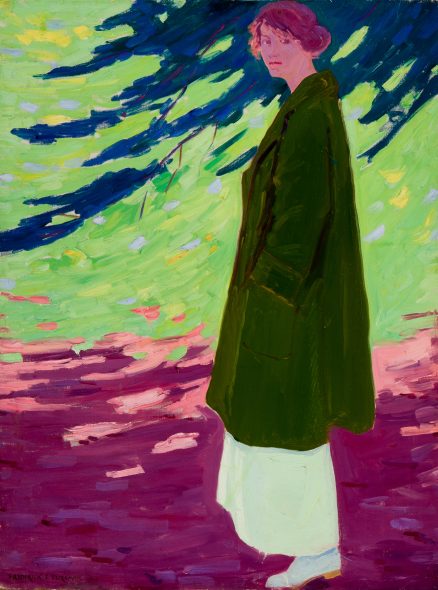Maizie under the Boughs (No. 16, Saugatuck, Michigan)
, dated 1915Oil on canvas, 40 by 30 inches
- Categories
- Figural works
- Women
- Zoom in on Artwork
- Print Page
- Email Page to Friend
Frederick Fursman’s Maizie under the Boughs (No. 16, Saugatuck, Michigan) captures the exaggerated color and flattened sense of depth that result from the dramatic contrast of dense shade and brilliant sunlight. Filling the vertical expanse of the canvas, a young woman stands sideways in the shadow cast by an evergreen tree whose branches sweep down from the upper right. The ground is starkly divided between areas of acid greens and purple and deep pink. These hues are echoed in the distorted tints of the woman’s face and of her skirt, presumably in reality a plain summer white, while the evergreen boughs appear a rich blue. Fursman’s reductive rendering of figure and tree branches as sharply bounded areas of nearly flat color evokes the relative blindness that results when eyes accustomed to full sunlight are turned on shadowed forms. Meanwhile, the divided strokes of paint that compose each of the two distinct sections of ground mimic the vibrating optical effect of midday glare.
By the early twentieth century, the theme of the female figure posed out-of-doors in bright daylight had become a standard among American impressionist painters. Fursman used it as a pretext for experimental exercises in abstract composition as he attempted to record purely visual perceptions of color and light. Maizie under the Boughs is among the boldest of a series of such paintings and one of several in which he posed women standing in or near the deep shade of woods. Most were painted during the summers Fursman spent as instructor and director in the Summer School of Painting at Saugatuck (now known as Ox-Bow), on the shore of Lake Michigan. These works may have served as aids in Fursman’s teaching of outdoor figure painting, the influence of which can be seen in his pupil Arthur K. Houlberg’s A Saugatuck Friend.
From the beginning of his painting career just after the turn of the century, Fursman had favored the loaded brush and bold brushwork seen in Maizie under the Boughs. With his return to the Midwest from studies abroad, in 1909, he exchanged the somber light of overcast skies typical of northern France for Saugatuck’s crisp atmosphere and direct light and their attendant striking tonal and color contrasts. In 1913, these assumed unprecedented centrality in Fursman’s art thanks to new influences on the artist. That spring, he undoubtedly visited the Armory Show at the Art Institute of Chicago, where he would have seen the advanced work of French Post-Impressionist, Fauvist, and German expressionist painters, with their concern for abstract form and expressive, non-naturalistic color. Within months of the Armory Show, Fursman returned to France. During the ten months he spent working in rural Brittany, he painted with a new emphasis on decorative effect and the dynamic juxtaposition of colors on the flat surface of the canvas. Joining that to Saugatuck’s clear, brilliant light in Maizie under the Boughs, Fursman reached the culmination of his engagement with modernist experimentation.
Wendy Greenhouse, PhD
Donated by M. Christine Schwartz to the Krannert Art Museum, University of Illinois Urbana-Champaign, Champaign, Illinois, in 2025
